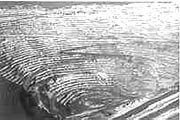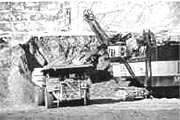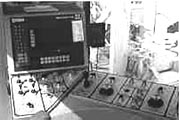

It is the Bingham Canyon Mine, an open pit excavation two and a half miles wide and three quarters of a mile deep and still growing.
At such immense size, the Bingham Canyon Mine, located 18 miles southwest of Salt Lake City, UT, easily outranks all other man-made excavations. It is also one of the largest mines in the world.
"According to NASA, there are only two man-made things you can see from space. One is the Great Wall of China and the other is Bingham Canyon," said John Kinneberg, Manager Business Improvement, and former Mine Operations Superintendent for Kennecott Utah Copper Corp., which owns and operates the huge mine.
The Bingham Canyon Mine, which produces copper, gold, silver, molybdenum, and some rare metals like platinum and palladium, has been in operation for more than a century. The first mining at the site occurred in the 1860s when prospectors discovered rich lead, zinc, gold and silver ore deposits literally rising from the earth.

"We brought in steam shovels similar to those used to dig the Panama Canal to test whether you could successfully mine 2,000 tons of ore a day," Kinneberg said.
In 2000, the huge mine is expected to produce 63.1 million tons of ore and 123.6 million tons of waste, for a total of 186.7 million tons of material to be taken from the pit, Kinneberg said.

Kennecott's state-of-the-art smelter utilizes the concentrate that comes from Bingham Canyon's ore to produce some 320,000 tons of copper a year, plus four million ounces of silver and about 500,000 ounces of gold and 21 million pounds of molybdenum, which is used to harden steel and for lubricant production.
One of the key steps in obtaining ore for the copper production is the blasthole drilling. Kinneberg said Kennecott annually drills some 3.4 million feet of blastholes, or enough to drill a hole from Salt Lake City to Los Angeles.
A crew of 24 drillers, 13 blasters, and one operator-trainer are involved in the drilling and blasting process. Kinneberg said the company drills about 58,300 holes per year, or about 160 per day using seven track-mounted Bucyrus Erie 49R drilling rigs and two P&H 120A rigs with 120,000 pounds of pulldown force. One smaller Ingersoll-Rand DMM3 is also used at times.
The blastholes range from 12-1/4 to 13-3/4 inches in diameter and they're drilled in patterns ranging from 22-by-25 feet to 34-by-39 feet. A one pound cast primer is placed in the bottom of each hole and the hole is filled about half full with explosives. Kinneberg said the explosives are ammonium-nitrate-based waterproof slurry or ammonium nitrate and fuel oil. Cuttings from the drilling operation are used to fill the remaining space in each hole to contain the explosion. Delays, both surface and down hole, are used to help control noise and vibration from the blast.

He said the company drills and blasts seven days a week and has a goal of two blasts per day.
Noting that "right now a pound of apples cost more than a pound of copper," Kinneberg said it is critical for the company to use the best equipment and technology possible in its operations.
He said the company's drill rigs are equipped with automatic drilling features which allow them to automatically level themselves and drill to a certain pulldown rate. The drills also have remote control capabilities which allow the operator to move around the drilling site and control the rig, including moving and steering it, from a chest-mounted operating pack.
The rigs also are equipped with Thunderbird Pacific drill monitors which monitor all facets of the drill's operations, the driller's actions in controlling the rig, and problems during operation. The system helps increase drill availability and productivity, and improves operator accountability for the drill, Kinneberg said.
Each rig is equipped with equipment allowing the use of US Global Positioning System satellites and the Russian Glonass positioning satellites to precisely locate boreholes at desired locations. The precise borehole locations provided by the systems ensures reduction in overdrilling or underdrilling in certain areas, provides automatic hole survey capabilities and captures hardness zone data for blasting.
Kinneberg said that studies are under way to determine if the drills can be fully automated so information can be sent directly to the crawler-mounted rigs to move themselves from site to site and drill the borehole without need for a full-time operator to oversee the process.
When the blasting is completed, 10 massive P&H electric shovels with dippers ranging from 30 to 56 cubic yards swing into action. The huge shovels are used to load an equally mammoth-sized fleet of 63 Caterpillar and Komatsu trucks with capacities ranging from 252 to 360 tons per load.
Efforts also are in progress to monitor operations of the shovels and their dippers to maximize their productivity, Kinneberg said.
"In an integrated blast management system, we would know everything from how the hole was drilled to how the loading is going to maximize productivity," he said.
"With metal prices what they are right now, we have to work very hard to insure we continually lower our costs and increase our productivity," Kinneberg said.
Although the massive mine has produced about 16 million tons of copper to date, a large enough orebody is present at the site to permit open pit mining through 2012 and underground mining for an additional 15 to 20 years.
Report Abusive Comment